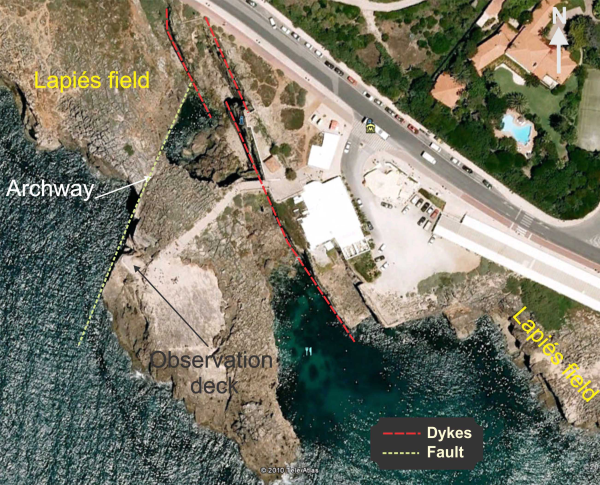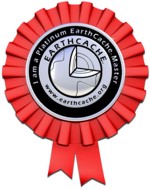From the guidelines, as from January 2013: "People do not need to wait for permission to log your EarthCache. Requiring someone to wait is not supported by the EarthCache guidelines. People should send their logging task answers to you, then log your EarthCache. When you review their logging task answers, if there is a problem, you should contact them to resolve it. If there is no problem, then their log simply stands."

Boca do Inferno (Portuguese for Hell's Mouth) is a chasm located in the seaside cliffs close to the city of Cascais, in the District of Lisbon.
This geological feature is probably one of the best known in the Cascais area and has an almost century old reputation of being a suitable place for committing suicide particularly in the 1920’s…….or so the stories go.
Today this unique geological feature consists of a rock archway open to the sea and a small recess in the limestone outcrops that is open skyward due to the collapse of the “roof”.
The theories on its formation are linked with the outcrop of two, close-by NNW-SSE trending dykes and the formation of a sea cave that has since collapsed leaving only the entrance archway intact.

The local geology is simple. Boca do Inferno is set within a large lapiés field (see adjacent cache: Ups and downs - DP/EC42) comprised of reef limestones of Lower Cretaceous (Hauterivian – Barremian; 136.4 to 125 M.a.) age striking NE and dipping gently to the SE cut occasionally by igneous dykes.
In order to claim a find in this EarthCache you have to get yourself to the coordinates supplied. There, answer the following questions:
1. What is the thickness of the rock strata that forms the archway?_______ metres.
2. Within the “old collapsed cave” is another archway. A) How long is it? And B) how wide is it?
3. From your vantage point are the walls to the west smooth or do they have large irregularities? (not counting the obvious small cracks).
Because I want this to be a “kid friendly” and safe EarthCache in days of bad weather, you have the option of going to the alternate waypoint supplied and answer the following questions for a found.
1. What is the small building to the right of the gates (when you face the pathway to the observation platform)?
2. What feature sits on the top of the eastern corner of the building?
3. What is the name of the kiosk at the bottom of the stairs on your left hand side as you exit Boca do inferno?
If you feel you have all the answers correct, please log your found but also send me the answers via e-mail so I can check them. If I don’t answer you it is because they are correct and you have another found.Please note that when you e-mail me, please supply the reference (GC28JGQ) and name (Boca do Inferno - DP/EC55) of the cache and please click on the “I want to send my e-mail address along with this message” so that when I reply to you the messages don’t go into e-mail heaven (or hell).


A Boca do Inferno é uma formação geológica única situada numa falésia à beira-mar perto da cidade de Cascais, no distrito de Lisboa. Esta particularidade geológica é provavelmente um dos mais conhecidos pontos de turismo na área de Cascais e tem uma reputação quase centenária de ser um lugar apropriado para se suicidar em especial na década de 1920 ... .... ou pelo menos rezam as histórias.
no distrito de Lisboa. Esta particularidade geológica é provavelmente um dos mais conhecidos pontos de turismo na área de Cascais e tem uma reputação quase centenária de ser um lugar apropriado para se suicidar em especial na década de 1920 ... .... ou pelo menos rezam as histórias.
Hoje, esta formação geológica única consiste num arco de pedra frente ao mar e um pequeno recesso nos afloramentos calcários a céu aberto devido ao colapso do "tecto".
As teorias sobre sua formação estão relacionados com o afloramento de dois diques orientados NNW-SSE e a formação de uma caverna junto ao mar que, desde então, desabou, deixando apenas a entrada com o seu arco intacto.

A geologia local é simples. A Boca do Inferno situa-se dentro de um grande campo de lapiás (ver cache adjacente: Altos e baixos - DP/EC42) que é composto por calcários recifais do Cretáceo Inferior (Hauteriviano - Barremiano; 136,4-125 Ma) com orientação para NE mergulhando suavemente para SE e ocasionalmente cortados por diques de rochas ígneas.
A fim de reivindicar um found nesta EarthCache dirigiam-se às coordenadas fornecidas. Aqui reúne os dados necessários para poderes reponder às seguintes perguntas:
1. Qual é a espessura da camada rochosa que forma o arco ?_______ metros.
2. Dentro da "velha caverna abatida" há mais um arco. Que tamaho tem? Qual a sua largura?
3. Do seu ponto de vista são as paredes, a oeste lisas ou têm grandes irregularidades?
Porque quero que esta seja uma EC "kid friendly" em dias de mau tempo, tens a opção de ir para o waypoint alternativo e responder às seguintes perguntas:
1. O que é o pequeno prédio isolado à direita (quando estás de frente para o caminho que segue para a plataforma de observação) dos portões?
2. O que está pendurado em cima na esquina este deste edifício?
3. Qual é o nome do quiosque ao fundo das escadas quem sai (à esquerda) da Boca do inferno?
Se achas que tens as respostas correctas, faz o teu log de "found", mas envia-me também as respostas por e-mail para que eu possa vê-las. Se eu não te responder é porque elas estão correctas.
Por favor, nota que quando me enviares um e-mail, por favor forneçe a referência (GC28JGQ) e nome (Boca do Inferno - DP/EC55) da cache e clica em “I want to send my e-mail address along with this message” para que quando eu responder as mensagens não sigam para o saco roto do geocaching.com.

 The most exciting way to learn about the Earth and its processes is to get into the outdoors and experience it first-hand. Visiting an Earthcache is a great outdoor activity the whole family can enjoy. An Earthcache is a special place that people can visit to learn about a unique geoscience feature or aspect of our Earth. Earthcaches include a set of educational notes and the details about where to find the location (latitude and longitude). Visitors to Earthcaches can see how our planet has been shaped by geological processes, how we manage the resources and how scientists gather evidence to learn about the Earth. To find out more click HERE.
The most exciting way to learn about the Earth and its processes is to get into the outdoors and experience it first-hand. Visiting an Earthcache is a great outdoor activity the whole family can enjoy. An Earthcache is a special place that people can visit to learn about a unique geoscience feature or aspect of our Earth. Earthcaches include a set of educational notes and the details about where to find the location (latitude and longitude). Visitors to Earthcaches can see how our planet has been shaped by geological processes, how we manage the resources and how scientists gather evidence to learn about the Earth. To find out more click HERE.
